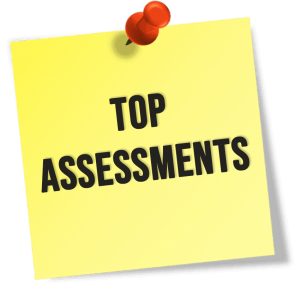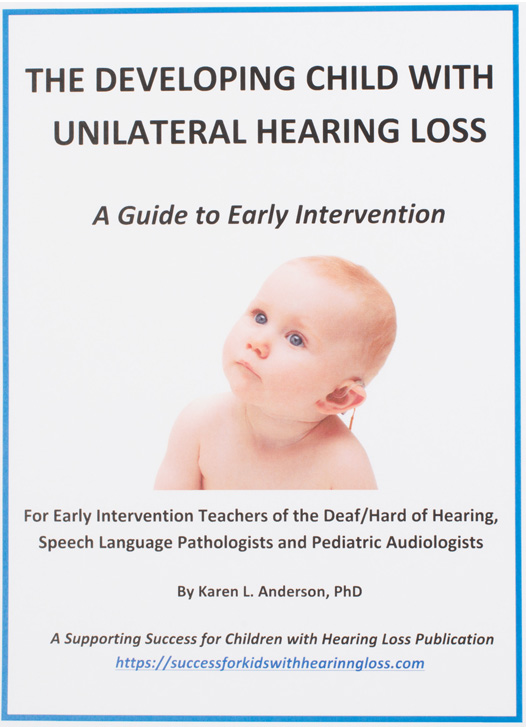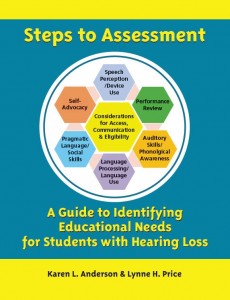Related Products
For Professionals
- Amplification
- Assessment of Student Skills, Challenges, Needs
- Early Childhood: Infants, Toddlers, Preschool
- Hearing Loss – Identification, Impact and Next Steps
- IDEA Law Summary Information
- Language and Speech Development Issues
- Legal Issues in Serving Children with Hearing Loss
- Listening (Auditory Skills) Development
- Planning to Meet Student Needs
- Self-Advocacy Skills for Students with Hearing Loss
- Self-Concept: How the Child with Hearing Loss Sees Himself
- Social Skills
- Speech Perception & Learning
Related Teacher Tools Takeout Items
Our Top Assessments to Use with Students who are DHH
 Assessment is required for all students who are deaf or hard of hearing (DHH) with IEPs or who are seeking eligibility for an IEP. IDEA requires that assessments tailored to the (suspected) disability area be used, but the question is WHICH assessments should be used? There are many, many checklists, functional assessments, and norm-referenced tests that could be used. This article includes mention of our top choices and a link to download a more complete list of possible assessments.
Assessment is required for all students who are deaf or hard of hearing (DHH) with IEPs or who are seeking eligibility for an IEP. IDEA requires that assessments tailored to the (suspected) disability area be used, but the question is WHICH assessments should be used? There are many, many checklists, functional assessments, and norm-referenced tests that could be used. This article includes mention of our top choices and a link to download a more complete list of possible assessments.
Although 80% of children born deaf in the developed world receive cochlear implants, the success rate with cochlear implants is highly variable (and other hearing devices) and cannot be assumed to ever ‘fix’ all language development issues, even for children with the best outcomes. We must consistently communicate with our school teams that students with hearing loss are not language disordered. Language, social, and reading delays occur secondary to lifelong decreased access to communication. This article focuses on assessments for students who primarily use listening for learning. An upcoming article will focus on assessment of students who use ASL as their primary communication mode.
The Necessity of Functional Assessments
Functional and academic performance differences for students with hearing loss are due to restricted access to spoken language, not to an inherent learning disability. Thus, if we are to provide accurate and relevant information for a student’s Present Levels of Academic Achievement and Functional Performance (PLAAFP statement), it is necessary to assess how a student is accessing communication across school environments.
Our Favorite Functional Assessments
1. Classroom observation by someone with a background and experience in the impacts of hearing loss on classroom, social, and learning behaviors. Here is a tool to guide your classroom observation.
2. Obtain the classroom teacher’s viewpoint on how the student is performing in comparison to peers. Just by filling out a checklist a teacher’s awareness of the potential impacts of hearing loss can increase. These checklists can identify specific areas to explore with more formal assessments. Our favorites:
a. The SIFTERs – Screening Instrument For Targeting Educational Risk: Preschool, Elementary, Secondary. Routinely ‘SIFTER’ your students in October and May.
b. Get more information by having the teacher complete one or more of the Placement and Readiness Checklists (PARC).
c. Listening Inventory For Education – Revised: Teacher Appraisal has two parts, one page to assess functional listening difficulty and the second page to gauge student’s self-advocacy strategy use and overall instructional access.
3. Estimate level of speech perception / communication access. We need to answer the question: “I know he has a hearing loss, but how much does it impact what he can understand?” The first step is to assess speech perception, looking specifically at the speech sounds that a student has difficulty accessing under different listening conditions. We all realize that listening in quiet to a person speaking within a couple of feet is optimal for students who are hard of hearing – but this condition isn’t what most classroom listening is like. Our favorites:
a. The Functional Listening Evaluation is the ‘gold standard’ for assessing speech perception in school. The Recorded Functional Listening Evaluation Using Sentences lets you administer recorded sentences using your smart phone or other media device plus a small speaker. Focus on listening with and without visual cues, in quiet and noise, and near (3 feet) and far (12 feet). Learn how to administer the recorded FLE. For grades 1 and up.
b. For students younger than grade 1, or as an additional functional assessment, we like the ELFLing Procedure. It requires the student to repeat Ling sounds presented from different distances and in quiet and noise (with no visual cues). Results are helpful in explaining to teachers why they can ‘see the child hear’ but the student does not (always) understand.
The Necessity of Caution when Interpreting Normed Test Results
 One strong finding from the robust 2015 Outcomes of Children with Hearing Loss Study was that normative test scores overestimate the abilities of children who are hard of hearing as they are unlikely to reflect the level of effort that students are expending to maintain competitiveness with peers.
One strong finding from the robust 2015 Outcomes of Children with Hearing Loss Study was that normative test scores overestimate the abilities of children who are hard of hearing as they are unlikely to reflect the level of effort that students are expending to maintain competitiveness with peers.
During review of assessments during eligibility determinations, 3-year evaluations, or annual testing, we must continually remind the school team that norm-referenced results routinely underestimate the challenges of students who are DHH, requiring even more focus on functional performance to reveal access concerns with an impact on social behavior and learning.
Our Favorite Norm-Referenced Assessments
1. The Listening Comprehension Test – Elementary / Adolescent looks at student identification of the main idea, details, reasoning (inference), vocabulary, and understanding messages. Results reflect well what the student can do with what they hear. We suggest that the student NOT be allowed to speech read during the test setting and that their ‘typical’ hearing technology be used (if the student is rejecting hearing aids or hearing assistance technology, test without). If a student uses ASL, have the classroom interpreter present when administering the test to reveal how well the student comprehends what was presented. This break from standard administration must be reported. Even so, if the Deaf student is in the regular classroom and expected to perform as well as class peers, results of the LCT can provide insights into equality of comprehension to age expectations.
2. Developmental Test of Auditory Performance This test is ideal to use in a climate where normed test results are respected more highly than functional assessments. While the FLE is the gold standard, the results are sometimes not taken as an indication of a disability being present. During the DTAP the student listens to a CD and performance is compared to typically hearing students. Results are for listening in quiet and noise, with language-based and environmental sound-based items. Helps to answer the question, “How much is the student’s language level helping/hurting auditory comprehension”.
3. “How much does the student understand with what s/he hears?” is such a critical question it is important to fully explore comprehension of typical teacher information. Both the Assessment of Story Comprehension (ages 3-4) and the Oral Passage Understanding Scale (age 5-21) present different passages about which the student then answer questions. Results help to clarify how effectively a student can communicate (listen AND understand) as compared to age/class peers. As with the LCT above, the OPUS can be administered with the use of the student’s classroom ASL interpreter.
4. The Test of Language Processing Skills (TAPS) is a favorite because it assesses phonological processing (our students very often have phonological awareness skill gaps), auditory memory (hearing words incompletely translates into challenges remembering what is heard), and listening comprehension. Our students who are hard of hearing require that auditory memory be assessed and few tests do this.
5. Pragmatic language is another area that is typically weak to develop for children with hearing loss so it is necessary to include this in your assessment. This can be a part of the evaluation performed by the speech language pathologist or the teacher of the deaf/hard of hearing. A normed teacher checklist we like is the Pragmatic Language Skills Inventory or a full assessment can be done using the Social Language Development Test.
Don’t Neglect to Assess Listening Skills!
 Most students with hearing loss are hard of hearing and will depend on listening to learn. Typically hearing children learn almost all skills in the auditory hierarchy by age 4, whereas children with hearing loss are delayed or have patchy development that reflects the consistency and clarity of their daily hearing. All need to be assessed to identify where their listening skills lie in comparison to the auditory hierarchy.
Most students with hearing loss are hard of hearing and will depend on listening to learn. Typically hearing children learn almost all skills in the auditory hierarchy by age 4, whereas children with hearing loss are delayed or have patchy development that reflects the consistency and clarity of their daily hearing. All need to be assessed to identify where their listening skills lie in comparison to the auditory hierarchy.
A recent US court case made it clear that students with hearing loss must receive an eligibility assessment that identifies areas of suspected need secondary to hearing loss must be evaluated with sufficient intensity to satisfy in depth evaluation. The crux of the case surrounded a lack of appropriate assessment of listening skills.
1. Does the student seem ‘pretty okay’ in how they listen? Use the Activities for Listening and Learning (ALL) checklist to review the many levels of listening skills, including those higher levels necessary for classroom success.
2. The best assessment out there is still the SPICE! The Speech Perception Instructional Curriculum & Evaluation has plenty of toys and cards to use as you assess skills, and a complete teaching curriculum. It takes some time to really learn how to use it, but nothing is better!
More Information
- Steps to Assessment – Guide to Identifying Educational Needs for Students with Hearing Loss. Includes student case studies with examples of test results in reports. This book presents vulnerable areas of development that need to be assessed and suggests some assessments. COURSE – Steps to Assessment
- Tailored Assessment for Students with Hearing Loss – 3-page article
- Resources for Identifying DHH Student Needs: Eligibility and Beyond – provides a list of functional and formal assessments for preschool and school age students.
- Supporting Success Assessment Products category from our catalog.
Author: Author: Karen L. Anderson, PhD
Click here to download this article


